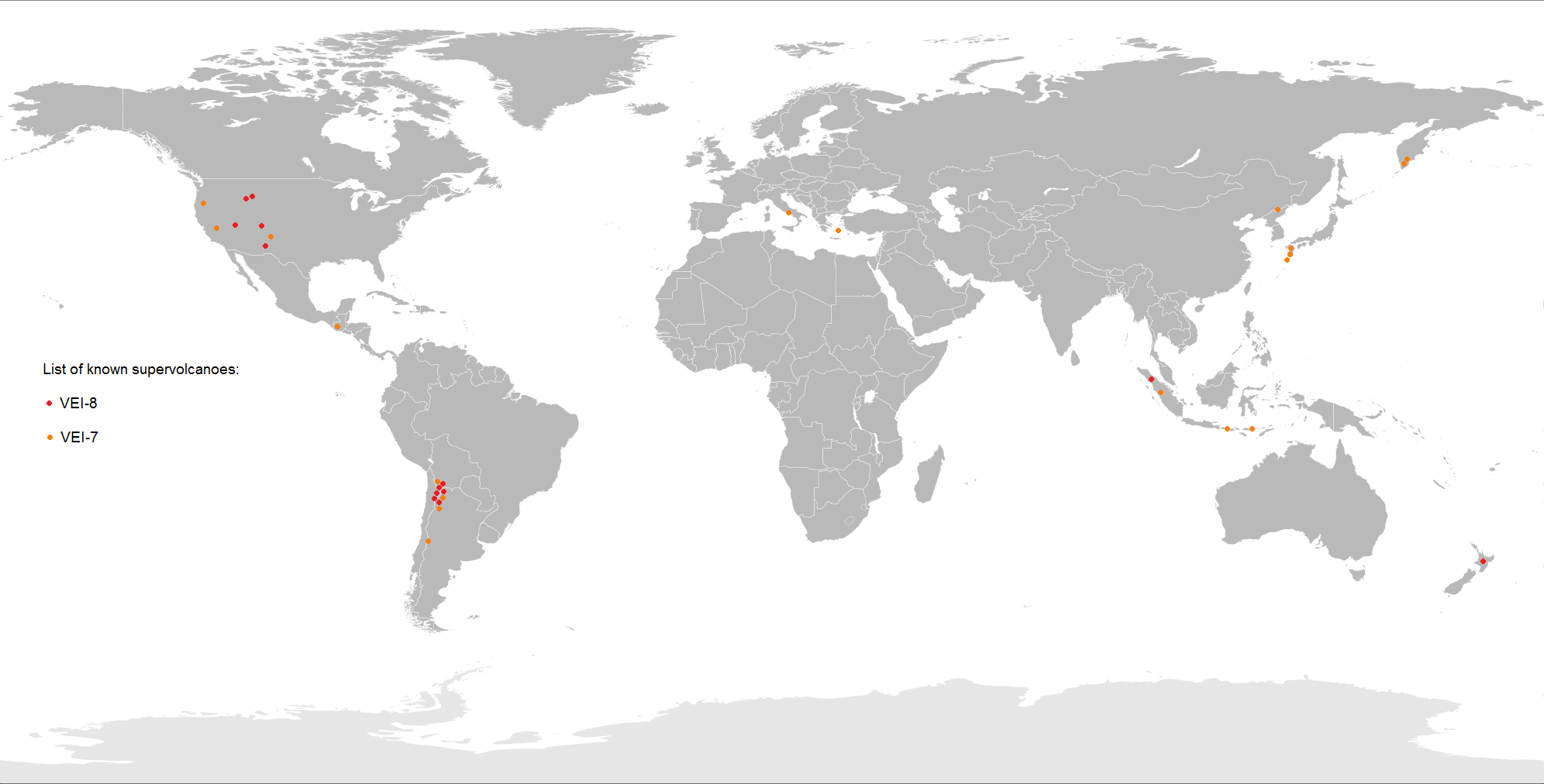|
Phlegraean Fields
The Phlegraean Fields ( it, Campi Flegrei ; nap, Campe Flegree, from Ancient Greek 'to burn') is a large region of supervolcanic calderas situated to the west of Naples, Italy. It was declared a regional park in 2003. The area of the caldera consists of 24 craters and volcanic edifices; most of them lie under water. Hydrothermal activity can be observed at Lucrino, Agnano and the town of Pozzuoli. There are also effusive gaseous manifestations in the Solfatara crater, the mythological home of the Roman god of fire, Vulcan. This area is monitored by the Vesuvius Observatory. It is considered a supervolcano. The area also features bradyseismic phenomena, which are most evident at the Macellum of Pozzuoli (misidentified as a temple of Serapis): bands of boreholes left by marine molluscs on marble columns show that the level of the site in relation to sea level has varied. Geological phases Three geological phases or periods are recognised and distinguished. * The Fi ... [...More Info...] [...Related Items...] OR: [Wikipedia] [Google] [Baidu] |
Italy
Italy ( it, Italia ), officially the Italian Republic, ) or the Republic of Italy, is a country in Southern Europe. It is located in the middle of the Mediterranean Sea, and its territory largely coincides with the homonymous geographical region. Italy is also considered part of Western Europe, and shares land borders with France, Switzerland, Austria, Slovenia and the enclaved microstates of Vatican City and San Marino. It has a territorial exclave in Switzerland, Campione. Italy covers an area of , with a population of over 60 million. It is the third-most populous member state of the European Union, the sixth-most populous country in Europe, and the tenth-largest country in the continent by land area. Italy's capital and largest city is Rome. Italy was the native place of many civilizations such as the Italic peoples and the Etruscans, while due to its central geographic location in Southern Europe and the Mediterranean, the country has also historicall ... [...More Info...] [...Related Items...] OR: [Wikipedia] [Google] [Baidu] |
Supervolcano
A supervolcano is a volcano that has had an eruption with a Volcanic Explosivity Index (VEI) of 8, the largest recorded value on the index. This means the volume of deposits for such an eruption is greater than 1,000 cubic kilometers (240 cubic miles). Supervolcanoes occur when magma in the mantle rises into the crust but is unable to break through it. Pressure builds in a large and growing magma pool until the crust is unable to contain the pressure and ruptures. This can occur at hotspots (for example, Yellowstone Caldera) or at subduction zones (for example, Toba). Large-volume supervolcanic eruptions are also often associated with large igneous provinces, which can cover huge areas with lava and volcanic ash. These can cause long-lasting climate change (such as the triggering of a small ice age) and threaten species with extinction. The Oruanui eruption of New Zealand's Taupō Volcano (about 26,500 years ago) was the world's most recent VEI-8 eruption. Terminol ... [...More Info...] [...Related Items...] OR: [Wikipedia] [Google] [Baidu] |
ScienceDaily
''Science Daily'' is an American website launched in 1995 that aggregates press releases and publishes lightly edited press releases (a practice called churnalism) about science, similar to Phys.org and EurekAlert!. The site was founded by married couple Dan and Michele Hogan in 1995; Dan Hogan formerly worked in the public affairs department of Jackson Laboratory The Jackson Laboratory (often abbreviated as JAX) is an independent, non-profit biomedical research institution which was founded by a eugenicist. It employs more than 3,000 employees in Bar Harbor, Maine; Sacramento, California; Farmington, ... writing press releases. The site makes money from selling advertisements. As of 2010, the site said that it had grown "from a two-person operation to a full-fledged news business with worldwide contributors". At the time, it was run out of the Hogans' home, had no reporters, and only reprinted press releases. In 2012, Quantcast ranked it at 614 with 2.6 million U.S ... [...More Info...] [...Related Items...] OR: [Wikipedia] [Google] [Baidu] |
Ice Core
An ice core is a core sample that is typically removed from an ice sheet or a high mountain glacier. Since the ice forms from the incremental buildup of annual layers of snow, lower layers are older than upper ones, and an ice core contains ice formed over a range of years. Cores are drilled with hand augers (for shallow holes) or powered drills; they can reach depths of over two miles (3.2 km), and contain ice up to 800,000 years old. The physical properties of the ice and of material trapped in it can be used to reconstruct the climate over the age range of the core. The proportions of different oxygen and hydrogen isotopes provide information about ancient temperatures, and the air trapped in tiny bubbles can be analysed to determine the level of atmospheric gases such as carbon dioxide. Since heat flow in a large ice sheet is very slow, the borehole temperature is another indicator of temperature in the past. These data can be combined to find the climate m ... [...More Info...] [...Related Items...] OR: [Wikipedia] [Google] [Baidu] |
Homo Sapiens
Humans (''Homo sapiens'') are the most abundant and widespread species of primate, characterized by bipedalism and exceptional cognitive skills due to a large and complex brain. This has enabled the development of advanced tools, culture, and language. Humans are highly social and tend to live in complex social structures composed of many cooperating and competing groups, from families and kinship networks to political states. Social interactions between humans have established a wide variety of values, social norms, and rituals, which bolster human society. Its intelligence and its desire to understand and influence the environment and to explain and manipulate phenomena have motivated humanity's development of science, philosophy, mythology, religion, and other fields of study. Although some scientists equate the term ''humans'' with all members of the genus ''Homo'', in common usage, it generally refers to ''Homo sapiens'', the only extant member. Anatomically mod ... [...More Info...] [...Related Items...] OR: [Wikipedia] [Google] [Baidu] |
Neanderthal
Neanderthals (, also ''Homo neanderthalensis'' and erroneously ''Homo sapiens neanderthalensis''), also written as Neandertals, are an extinct species or subspecies of archaic humans who lived in Eurasia until about 40,000 years ago. While the "causes of Neanderthal disappearance about 40,000 years ago remain highly contested," demographic factors such as small population size, inbreeding and genetic drift, are considered probable factors. Other scholars have proposed competitive replacement, assimilation into the modern human genome (bred into extinction), great climatic change, disease, or a combination of these factors. It is unclear when the line of Neanderthals split from that of modern humans; studies have produced various intervals ranging from 315,000 to more than 800,000 years ago. The date of divergence of Neanderthals from their ancestor '' H. heidelbergensis'' is also unclear. The oldest potential Neanderthal bones date to 430,000 years ago, but the classification ... [...More Info...] [...Related Items...] OR: [Wikipedia] [Google] [Baidu] |
Late Pleistocene
The Late Pleistocene is an unofficial age in the international geologic timescale in chronostratigraphy, also known as Upper Pleistocene from a stratigraphic perspective. It is intended to be the fourth division of the Pleistocene Epoch within the ongoing Quaternary Period. It is currently defined as the time between c. 129,000 and c. 11,700 years ago. The Late Pleistocene equates to the proposed Tarantian Age of the geologic time scale, preceded by the officially ratified Chibanian (formerly known as Middle Pleistocene) and succeeded by the officially ratified Greenlandian. The estimated beginning of the Tarantian is the start of the Eemian interglacial period ( Marine Isotope Stage 5). It is held to end with the termination of the Younger Dryas, some 11,700 years ago when the Holocene Epoch began. The term Upper Pleistocene is currently in use as a provisional or "quasi-formal" designation by the International Union of Geological Sciences (IUGS). Although the three olde ... [...More Info...] [...Related Items...] OR: [Wikipedia] [Google] [Baidu] |
Before Present
Before Present (BP) years, or "years before present", is a time scale used mainly in archaeology, geology and other scientific disciplines to specify when events occurred relative to the origin of practical radiocarbon dating in the 1950s. Because the "present" time changes, standard practice is to use 1 January 1950 as the commencement date (epoch) of the age scale. The abbreviation "BP" has been interpreted retrospectively as "Before Physics", which refers to the time before nuclear weapons testing artificially altered the proportion of the carbon isotopes in the atmosphere, which scientists must now account for. In a convention that is not always observed, many sources restrict the use of BP dates to those produced with radiocarbon dating; the alternative notation RCYBP stands for the explicit "radio carbon years before present". Usage The BP scale is sometimes used for dates established by means other than radiocarbon dating, such as stratigraphy. This usage differs from ... [...More Info...] [...Related Items...] OR: [Wikipedia] [Google] [Baidu] |
Lithophaga
''Lithophaga'', the date mussels, are a genus of medium-sized marine bivalve molluscs in the family Mytilidae. Some of the earliest fossil ''Lithophaga'' shells have been found in Mesozoic rocks from the Alps and from Vancouver Island.Ludvigsen, Rolf & Beard, Graham. 1997. West Coast Fossils: A Guide to the Ancient Life of Vancouver Island. pg. 102Kleemann, K.H., 1994. Mytilid bivalve ''Lithophaga'' in Upper Triassic coral ''Pamiroseris'' from Zlambach Beds compared with Cretaceous ''Lithophaga alpina''. Facies 30, 151-154. The shells of species in this genus are long and narrow with parallel sides. The animals bore into stone or coral rock with the help of pallial gland secretions,"integument (mollusks)."Encyclopædia Britannica. 2009. Encyclopædia Britannica 2006 Ultimate Reference Suite DVD hence the systematic name ''Lithophaga'', which means "stone-eater". Their club-shaped borings are given the trace fossil name '' Gastrochaenolites''. Species Species within the genus ... [...More Info...] [...Related Items...] OR: [Wikipedia] [Google] [Baidu] |
Gastrochaenolites
''Gastrochaenolites'' is a trace fossil formed as a clavate (club-shaped) boring in a hard substrate such as a shell, rock or carbonate hardground. The aperture of the boring is narrower than the main chamber and may be circular, oval, or dumb-bell shaped (Kelly and Bromley, 1984). ''Gastrochaenolites'' is most commonly attributed to bioeroding bivalves such as ''Lithophaga ''Lithophaga'', the date mussels, are a genus of medium-sized marine bivalve molluscs in the family Mytilidae. Some of the earliest fossil ''Lithophaga'' shells have been found in Mesozoic rocks from the Alps and from Vancouver Island.Ludvigsen, ...'' and ''Gastrochaena'' (Kleeman, 1980). The fossil ranges from the Ordovician to the Recent (Taylor and Wilson, 2003; Vinn and Wilson, 2010). The first Lower Jurassic ''Gastrochaenolites'' ichnospecies is ''Gastrochaenolites messisbugi'' Bassi, Posenato, Nebelsick, 2017. This is the first record of boreholes and their producers (mytilid bivalves) in one of th ... [...More Info...] [...Related Items...] OR: [Wikipedia] [Google] [Baidu] |




